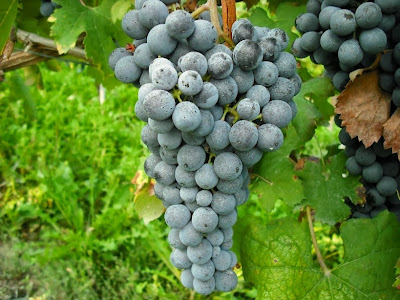Reading
the label… the wine was produced in 2005 by the Cascina Val del Prete winery in the Piedmont
region of northern Italy in the Nebbiolo d'Alba appelation (DOC). Vigna di Lino is
the name of the vineyard.
The Winery - Cascina Val del Prete
The name of the winery, Cascina Val del Prete, in Italian means
“Valley of the Priest” which is derived from the name of the exiled Bishop of
Asti who lived there in 1850. In 1977 Bartolomeo Roagna and his wife Carolina
bought the farm and then planted vines on
south facing slopes in a natural amphitheater and today have 27 acres. Their
sons, Mario and Luigi, now run the family business and take care of the
vineyards
The Vineyard - Vigna
di Lino
The vineyard, Vigna
di Lino, takes its name from Mario Roagna’s father. It is a tribute to the
vision and hard work that Mario’s father, helped by his mother Carolina, shared
for many years. The vineyard extends for about 3 acres on the left bank of the
Tanaro River. It’s at 900 feet above sea level and receives sun exposure to the
south. The vines are 30+ years old with a density of 2,300 plants per acre. The
vineyard is bio-dynamically fertilized.[1]
The Region - Piedmont
There are 20 wine regions in Italy, the three most important are Piedmont (Italian: Piemonte, “foot of the mountain“), Tuscany and Veneto. Piedmont is located in the north-west bordering France and
Switzerland. Piedmonte
is predominantly a plain where the water flows from the Swiss and French Alps
form the headwaters of the Po river. Alba is a town and comune in the province
of Cuneo. It is considered the capital of the hilly area of Langhe, Nebbiolo
d’Alba DOC is a large area
around the town of Alba. It received classification in 1970 and it is named
after the red grape Nebbiolo from which they are made, the same grape
that goes into the more prestigious Barolo and Barbaresco DOCG wines.
The Grape - Nebbiolo
The name of the grape Nebbiolo is thought to derive its name from the Italian
word nebbia which means “fog”.
During harvest,
which generally takes place late in October, a deep, intense fog sets into
the Langhe region
where many Nebbiolo vineyards are located. However, it may refer to the
fog-like milky veil that forms over the berries as they reach maturity or that
perhaps the name is derived instead from the Italian word nobile, meaning noble.[2]
The funny thing about Nebbiolo is that it is light in color and
produces wines that are light to medium ruby red and it is a thin skinned
grape, much like Pinot Noir. Yet unlike Pinot Noir this wine tends to be VERY
tannic. There
aren’t very many wineries that produce Nebbiolo,
but the few that I have purchased (such as the
2008
Jacuzzi Nebbiolo, Sonoma County) I bought
with the intention of laying them down for 5-10 years before opening them.
The Wine
The 2005 Cascina Val del Prete Nebbiolo d’Alba Vigna di Lino is ruby red with aromas
of dried roses, black pepper, dried herbs, mushrooms, restrained red and dark fruits
and a hint of anise. On the palate it is soft on entry and then the tannins
really grip the gums and teeth. It is medium bodied with ample acidity and a
medium length finish. Although this wine is already 8 years old, it could use
another 5+ to really come together. It would pair best with hearty meat dishes,
lamb or stew. This wine retails at around $50 at wine shops such as The Vine at Bridges in Danville,
California.
To visit or for more information:
The Vine at Bridges
480 Hartz Ave
Danville, CA 94526
Phone: 1-925-820-7210
Wine Bar Hours
Sunday:
12 (noon) - 7pm
Monday:
5 - 9pm
Tuesday
- Wednesday: 4 - 10pm
Thursday
- Saturday: 4 pm - 12:00 am
[1]
http://www.valdelprete.com/
[2] J. Robinson (ed), The Oxford
Companion to Wine Third
Edition (Oxford University Press, 2006), pg 470-471.

















